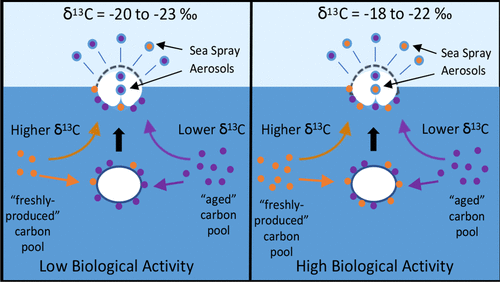当前位置:
X-MOL 学术
›
ACS Earth Space Chem.
›
论文详情
Our official English website, www.x-mol.net, welcomes your feedback! (Note: you will need to create a separate account there.)
Biological Influence on δ13C and Organic Composition of Nascent Sea Spray Aerosol
ACS Earth and Space Chemistry ( IF 3.4 ) Pub Date : 2020-08-07 , DOI: 10.1021/acsearthspacechem.0c00072 Daniel R. Crocker 1 , Ritchie E. Hernandez 1 , Haonan D. Huang 1 , Matthew A. Pendergraft 2 , Ruochen Cao 1 , Jiayin Dai 1 , Clare K. Morris 2 , Grant B. Deane 2 , Kimberly A. Prather 1, 2 , Mark H. Thiemens 1
ACS Earth and Space Chemistry ( IF 3.4 ) Pub Date : 2020-08-07 , DOI: 10.1021/acsearthspacechem.0c00072 Daniel R. Crocker 1 , Ritchie E. Hernandez 1 , Haonan D. Huang 1 , Matthew A. Pendergraft 2 , Ruochen Cao 1 , Jiayin Dai 1 , Clare K. Morris 2 , Grant B. Deane 2 , Kimberly A. Prather 1, 2 , Mark H. Thiemens 1
Affiliation

|
Elucidating the influence of oceanic biological activity on the organic composition of sea spray aerosol (SSA) is crucial to understanding marine cloud properties relevant to climate. Numerous marine field studies designed to address this topic have yielded conflicting results mainly as a result of the inability to distinguish primary SSA composition from terrestrial and marine secondary organic aerosols. In this study, two laboratory-induced phytoplankton blooms were conducted in an isolated system without background aerosol contributions. Values for δ13C were measured for SSA (δ13CSSA) along with seawater particulate and dissolved organic carbon (δ13CPOC and δ13CDOC) to track changes in carbon transfer and composition between seawater and SSA. Contrary to common assumptions, δ13CSSA values were not equivalent to δ13CDOC. The consistently less negative δ13CSSA values indicate that nascent δ13CSSA reflects specific changes in relative contributions to SSA from the available seawater carbon pools, as a function of biological activity. A dual-source isotopic mixing model revealed that the difference between δ13CSSA and δ13CDOC was explained by increased relative contributions of “freshly produced” organic carbon (OC) to SSA, with the largest contribution of “freshly produced” OC occurring 2–3 days after the maximum chlorophyll-a concentrations. This finding is consistent with previous mesocosm studies, showing that organic enrichment in SSA requires processing by heterotrophic bacteria after periods of high primary productivity. This work examining the biological influences on SSA organic composition and nascent δ13CSSA values provides new insights into ocean-to-SSA carbon transfer dynamics, which can be used in future field studies to improve estimates of anthropogenic influences on the carbon composition of the marine environment.
中文翻译:

上δ生物影响13初生海C和有机构成喷雾气溶胶
阐明海洋生物活动对海浪气溶胶(SSA)有机组成的影响对于了解与气候有关的海洋云的性质至关重要。旨在解决该问题的许多海洋领域研究均产生了相互矛盾的结果,这主要是由于无法将主要SSA成分与陆地和海洋次生有机气溶胶区分开来。在这项研究中,在没有背景气溶胶作用的隔离系统中进行了两次实验室诱导的浮游植物水华。为δ值13测量了SSA(δ13 C 13 C ^ SSA)与海水的微粒沿和溶解的有机碳(δ 13 C ^ POC和δ 13 C ^ DOC),以追踪海水与SSA之间的碳转移和组成变化。与一般的假设,δ 13个Ç SSA值不等于δ 13 Ç DOC。一贯少负δ 13 C ^ SSA值表明初生δ 13 Ç SSA反映了从可用海水碳池SSA相对贡献的具体变化,作为生物活性的函数。双源同位素混合模型表明,δ之间的差13 Ç SSA和δ 13 C ^ DOC可以通过“新鲜生产的”有机碳(OC)对SSA的相对贡献增加来解释,其中“新鲜生产的” OC的最大贡献发生在最大叶绿素a浓度后2-3天。这一发现与以前的中观研究一致,表明SSA中的有机富集需要经过高初级生产力时期后由异养细菌进行处理。这项工作检查上SSA有机组合物和新生δ生物影响13个Ç SSA值提供新的见解海洋到SSA碳转移动力学,其可以在以后的实地研究被用来改善上的碳组合物人为影响的估计海洋环境。
更新日期:2020-09-18
中文翻译:

上δ生物影响13初生海C和有机构成喷雾气溶胶
阐明海洋生物活动对海浪气溶胶(SSA)有机组成的影响对于了解与气候有关的海洋云的性质至关重要。旨在解决该问题的许多海洋领域研究均产生了相互矛盾的结果,这主要是由于无法将主要SSA成分与陆地和海洋次生有机气溶胶区分开来。在这项研究中,在没有背景气溶胶作用的隔离系统中进行了两次实验室诱导的浮游植物水华。为δ值13测量了SSA(δ13 C 13 C ^ SSA)与海水的微粒沿和溶解的有机碳(δ 13 C ^ POC和δ 13 C ^ DOC),以追踪海水与SSA之间的碳转移和组成变化。与一般的假设,δ 13个Ç SSA值不等于δ 13 Ç DOC。一贯少负δ 13 C ^ SSA值表明初生δ 13 Ç SSA反映了从可用海水碳池SSA相对贡献的具体变化,作为生物活性的函数。双源同位素混合模型表明,δ之间的差13 Ç SSA和δ 13 C ^ DOC可以通过“新鲜生产的”有机碳(OC)对SSA的相对贡献增加来解释,其中“新鲜生产的” OC的最大贡献发生在最大叶绿素a浓度后2-3天。这一发现与以前的中观研究一致,表明SSA中的有机富集需要经过高初级生产力时期后由异养细菌进行处理。这项工作检查上SSA有机组合物和新生δ生物影响13个Ç SSA值提供新的见解海洋到SSA碳转移动力学,其可以在以后的实地研究被用来改善上的碳组合物人为影响的估计海洋环境。



























 京公网安备 11010802027423号
京公网安备 11010802027423号